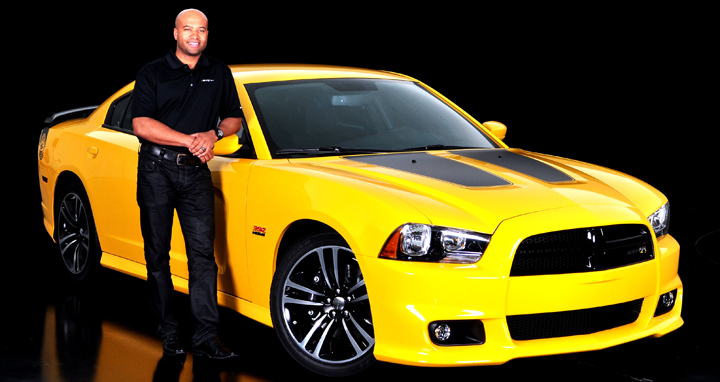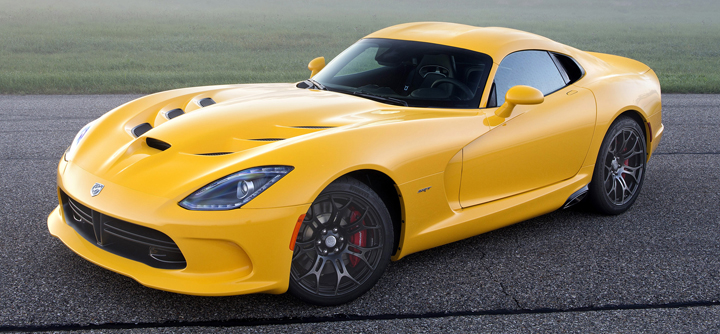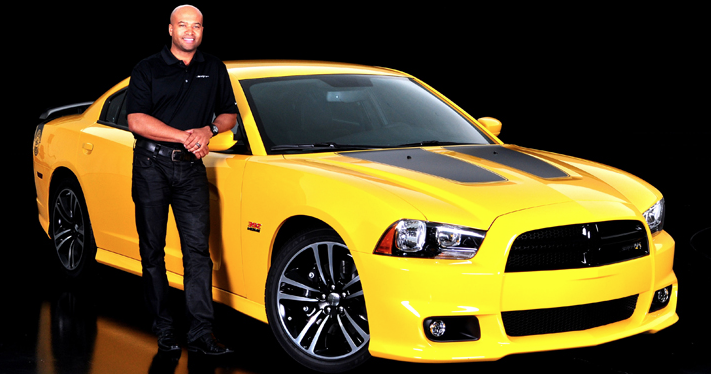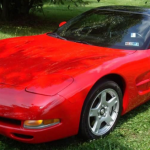
Chrysler’s Ralph Gilles is a busy guy these days. He is both the president and CEO of the SRT brand and Motorsports and the senior vice president of Product Design. Consumer Guide recently sat down with Ralph for a conversation about the relaunch of the Viper and the SRT brand in general.
Ralph Gilles Interview
Consumer Guide: It seems like the new Viper has moved upscale with this new generation. Is that where that market is going? Is there still a place for a raw, bare-bones sports car?
Ralph Gilles: It’s not that bare-bones. I would say we do make a relatively bare-bones one under $100,000, which is where the last generation left off. So we have [a Viper model] at $97,000 before shipping. In the world of supercars, there’s really nothing like it. It’s the fastest car under a hundred grand that I can think of—highest performance, incredible horsepower. What we’re finding is we know our customer very well. We know what they do with their cars, we know what they want. We’ve actually engaged with them for years, asking “What would you want in the next car?” A lot of them privately take the cars and get them leather-wrapped, or they get them repainted. They’re not happy with the stripes being on top of the paint. They want it in the clear coat. They want more choices for wheels. So we’ve basically made the Viper more bespoke, so people can make it what they want. No one wants to pull up and see the same car. They’re really into customizing and such, so it’s really the way you want it. It’s made to order, so you can get it for $100,000, or if you load it all the way up, you can get it north of $140,000.
CG: Do you anticipate that there will continue to be strong aftermarket interest in Viper?
RG: Oh yeah. The performance market is fairly strong. We’re actually very low volume. We’re not trying to do anything ridiculous with volume. We’re very conservative with our volumes, and that’s one of the reasons that prices have to be where they are, is to make the whole thing work out. Even if we wanted to, we’re not set up to make four, or five, or six thousand Vipers a year. We couldn’t do it. We don’t want to. That’s not what the car’s about.
CG: I saw recently that you had more dealer “hand-raisers” to sell [Viper] than you were expecting.
RG: Yeah, much more. I wanted it in the mid-200 range, and we got 430 dealers.
CG: Are you happy with that, or kind of nervous?
RG: I think it will regulate. It think over time it will—we know who the hardcore SRT guys are, the guys who understand performance and have the constituents around their store that go to them as experts. We know who they are, and I think over time they’ll be the ones who stick around.
CG: How does SRT interact with the Mopar brand?
RG: We share . . . obviously I’m good friends, the Mopar team and SRT team are friends, we hang out and do things together. We’re aware of each other’s projects, so we do some engineering on their behalf, and they do a lot of distribution on our behalf. So there’s a lot of behind-the-scenes work, and sometimes . . . we’re doing a spring set for the Grand Cherokee, for example, that we developed as a potential road version, but it was too low for what we wanted, so we handed it over to Mopar, and Mopar was able to offer that piece as a specialized-market part.
CG: That’s strictly for the SRT Grand Cherokee?
RG: Yeah. And there’s stuff like that on every car.
Future Collectibles: 2017 Dodge Viper
CG: SRT has a unique structure in that it’s both an in-house tuning division and a brand of its own. Is that the way you want it to continue, to have that dual-tiered arrangement?
RG: Yeah, and the reason is because we’ve had a history, through the Viper part of our history, of interfacing with our customers directly at car shows and events. Actually, this weekend I’m going to be at a Viper rendezvous here with 200-plus owners at their winter party, just hanging out. Several of our engineers are going. That’s very unusual for an OEM to engage with their customer, but we’ve become friends over the years. We learn a lot about what they want; we know what they want next.
What’s interesting is that it’s spilled over into Cherokees, Chargers, Challengers, and 300Cs because they have family cars. They say, “I’ll get an SRT8 Grand Cherokee because I have a Viper.” So there’s this amazing kindred spirit. The whole thing about SRT is giving these enthusiasts respect. By creating your own website specifically for the brand, that’s where they go. When they shop performance, they know where to go. There are conversations. . . . I don’t know if you’ve seen our website, but we’ve updated it since we’ve launched. It’s pretty cool now. If you spend even 15 minutes perusing it, you’ll get exactly what I’m talking about. We actually feature owners’ cars on the website. We give them tidbit interviews with behind-the-scenes information on their powertrains or braking system, live interviews, or taped interviews with the actual engineer that worked on their engine. They love that stuff. That would be a little awkward on a normal brand site. We go much deeper as a brand.
CG: I’m sure they appreciate that accessibility.
RG: Yeah, they feel special . . . and we know they’re special people. We know they’re a very special part of the entire market. You have to market to them differently, you have to interface with them differently.
CG: When you have that dialogue with them, what is the feedback that they’re giving you? What do they want product-wise?
RG: (Chuckles.) They always want more. More power, but a lot of them are starting to talk about accouterments. That’s one of the reasons the Viper, as you mentioned, has gone upscale. We offer different levels of interiors. So you can have the vinyl interior with the leather dash, or you can have all leather, or you can have premium leather with a special color as well. And that came from that conversation with them. Money is no object for some of these owners. They just want the best of what they can get.
CG: And personalization as well?
RG: Yeah, but they want it in an American car. They don’t want a Ferrari—I mean, I love Ferraris—but they don’t want Porsche, they don’t want any of that stuff. They want an American car.
CG: Along those lines, it seems that more than other manufacturers, Dodge has valued its muscle-car heritage. Do you see that continuing? Is there no end to the “High Impact” colors? Are those going to be eternal styling cues?
RG: That community is here for a while yet. There’s a generation that’s a little older that loves that stuff. But I have interfaced just yesterday at the University of Illinois talking to the young engineers, and they’re also enthusiasts, these auto/transportation engineers who want to go that direction in transportation, and they’re talking cars just like I did 25 years ago. So, that enthusiasm is there. There’s probably a little bit less of them, because there are other distractions in our day and age, but we’ll see. And things like color and impact configuration, we can tune that very quickly—within a model year, we can tune the flavor of the car very quickly. We never overdo it with volume, either. If we do a purple, or like we’re launching [the] Plum Crazy [color] again today, it’s going to be a limited amount of cars. We know it’s a special person that wants that.
CG: The way the internal structure happens . . . as SRT, do you basically go to Dodge, go to Jeep, go to Chrysler and say, “Give us this latest thing you’re working on, we want to do an SRT version of it,” or is that—
RG: In the old days it was like that. Now we get involved strategically from day one. We’re on our second generation of all these cars. The Viper is fifth generation, the other ones are second generation. So we were able to insert ourselves at the beginning. There are things that we needed in the car, little things, structural things, dimensional things. We got those in there right from the start. So we developed the cars commensurately with the base model. With the exception of Viper, everything else is made within the plant. That’s one of the reasons our cars are reasonably affordable compared to other performance cars. They’re made right next to the standard model, which makes it very efficient to build. And they’re modular—there are a lot of shared components between the cars, so it means the price is fairly reasonable for what they are.
So yeah, we go to each brand, but we don’t discuss it. Like I don’t have to knock on the door and say I need one of these. It’s more of a team decision, that hey, we think there’s a market for this car. The good news is because our cars are typically higher margin than the base car, it’s not an issue if you’re displacing—let’s say you just had capped capacity, and you’re displacing part of the base car [production volume]—it’s actually good for the business case, because you’re selling a higher-margin car within the same structure. So I have a very easy discussion as long as I can make the business case for it. They more than welcome us into their plant.
CG: So once you’re in on the ground floor, are you pretty autonomous?
RG: Yeah. We have a unique engineering team. We have our own requirements, our own specs, our own vehicle requirements, customer requirements, interiors. . . . The car is a system—from the seat, the steering wheel, the transmission calibration, some of the sub-components of the differential—everything is a system. We have to engineer it accordingly.
CG: So SRT has the image of being an upscale performance brand. Will you continue to grow that?
RG: Oh yeah, I want to go—upscale is something that happened to us. We didn’t—we wanted the Grand Cherokee to be upscale, the 300, but the Charger and Challenger to me are still very Middle America. There’s nothing wrong with that. They have upscale componentry; you can get features that you would associate to cars costing twice as much on the Charger—two-mode suspension, automatic cruise control, a lot of cool stuff . . . steering headlamps on the 300. So a lot of these really cool features. . . . It sounds like a Mercedes when you describe a 300C SRT8, and that’s cool. But, on the other hand, I know our community, there’s a young community, because we used to sell SRT4s, smaller cars. Clearly there’s an opportunity to go lower [with] smaller cars. And smaller cars doesn’t necessarily mean less expensive; it just means dimensionally different. It’s a misnomer that because a car is smaller, it’s cheaper. That’s not necessarily the case.
CG: Especially in today’s market, it seems like consumers are more understanding of a premium-priced small car.
RG: We’re about to enjoy an interesting time, where people—especially this next group of customers—are willing to . . . they don’t look at a car’s value by size, or engine size, either.
CG: So along those lines, is there any product that you would say, “Nah, I don’t think we could make an SRT version of that”?
RG: A minivan. (Laughs.) It’s funny, I say that, and I’ve been quoted saying that a minivan won’t be an SRT, but I always get responses like, “Why not? I would buy one!” But I think they’re in the minority.
CG: I think the Grand Caravan R/T was a cool thing.
RG: Yeah. And that’s about all I think the world needs.
CG: Would there be any opportunity for an SRT Ram?
RG: We’ve had one in the past. We had a Ram SRT 10. We’ll see. . . . It’s an interesting market. Ram has a great R/T already, and it’s actually even better this year. They’ve really done a nice job with the R/T—unique gearing, everything. So . . . I don’t know. I really don’t know. We haven’t shut the door on that idea, because we’ve had it in the past. We have some faithful owners who would like another one. But right now it’s nothing we’re working on.
CG: If there were to be a more performance-oriented off-road Ram—
RG: It’s not our specialty, I’ll be very frank with you.
CG: The “S” in SRT means street, so . . .
RG: Yeah, exactly. But it’s something . . . I’d be lying to you if I said it wasn’t something that hasn’t crossed our minds. If there’s anything that we can help, any expertise we can help combining with the base car program, by all means. The way the company is set up, we’re very collaborative with our projects.
CG: Can you say anything at this point about the Challenger’s future?
RG: The future is very bright. I’ll leave it at that.
Affordable Performance and One-Off Vipers: Brand Boss Tim Kuniskis on the Future of Dodge (Part 1)


Redesigned 2013 Viper: Stronger Bite, Softer Hiss
Ralph Gilles Interview



